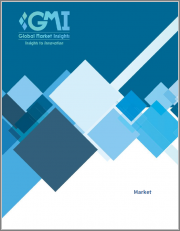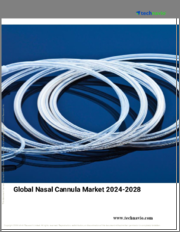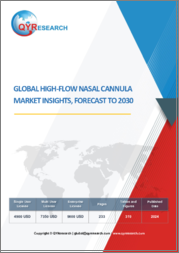
|
시장보고서
상품코드
1416171
비강 캐뉼라 시장 : 유형별, 재료별, 용도별, 최종 용도별 - 세계 예측(2023-2032년)Nasal Cannula Market - By Type, By Material, Application, End use - Global Forecast, 2023-2032 |
||||||
세계 비강 캐뉼라 시장은 호흡기 질환의 유행, 고령화, 기술 발전 등을 배경으로 2023년부터 2032년까지 6.2%의 성장률을 나타낼 것으로 예상됩니다.
WHO의 2022년 보고서에 따르면, 호흡기 감염은 전 세계 질병의 6%를 차지하며, 5세 미만 아동의 연간 사망자 수는 660만 명이며, 그 중 3분의 1은 저소득 국가의 급성 호흡기 감염(ARI)에 기인합니다. 노인 인구 증가와 이에 따른 호흡기 질환의 급증은 보조 산소 공급을 위한 중요한 도구로서 비강 캐뉼라에 대한 수요를 촉진하고 있습니다. 또한, 기존 산소마스크에 비해 편안함, 환자 순응도 등 제품의 장점에 대한 인식이 높아지면서 시장 성장을 더욱 가속화하고 있습니다. 사용 된 디자인과 재료의 기술적 발전은 업계의 궤도를 형성하고 의료 서비스 제공업체와 환자 모두를 매료시킬 것으로 보입니다.
실리콘 비강 캐뉼라 분야는 유연성, 내구성, 생체 적합성 등 우수한 특성으로 인해 2032년까지 전례 없는 성장을 이룰 것입니다. 편안한 착용감을 제공하여 피부 자극의 위험을 줄이고 환자의 만족도를 높입니다. 또한, 소재의 유연성으로 인해 환자의 얼굴 윤곽에 쉽게 적응할 수 있어 효율적인 산소 공급을 위한 안정적이고 밀착된 착용감을 보장합니다.
급성 호흡 부전 응용 분야는 2032년까지 상당한 성장을 보일 것으로 예상됩니다. 이 제품은 급성 호흡 부전 환자에게 산소 요법을 제공하는 데 사용되어 신속한 개입과 생명을 구하는 의료를 촉진합니다. 호흡기 응급 상황의 발생률이 증가하고 조기에 효과적인 호흡기 지원에 대한 중요성이 높아짐에 따라 신속하고 효율적인 산소 투여를 위해 급성 호흡 부전 용도를 위한 비강 캐뉼라의 통합이 증가할 것으로 보입니다.
아시아태평양의 비강 캐뉼라 시장 규모는 호흡기 관리 솔루션에 대한 수요 증가, 인구 증가, 의료 인프라의 부상, 호흡기 질환의 유병률 증가에 힘입어 2023년부터 2032년까지 급성장할 것으로 예상됩니다. 중국과 인도와 같은 국가들은 호흡기 건강의 중요성에 대한 인식이 높아지고 환자층이 확대되면서 이러한 성장의 최전선에 서 있습니다. 시장 관계자들은 아시아태평양에서의 입지를 확대하는 데 전략적으로 초점을 맞추고 있으며, 이 지역의 진화하는 의료 환경의 미개척 기회를 활용하고 있습니다.
목차
제1장 조사 방법과 조사 범위
제2장 주요 요약
제3장 비강 캐뉼라 산업 인사이트
- COVID-19의 영향 분석
- 생태계 분석
- 기술 상황
- 규제 상황
- 업계에 대한 영향요인
- 성장 촉진요인
- 업계의 잠재적 리스크&과제
- 성장 가능성 분석
- Porter's Five Forces 분석
- PESTEL 분석
제4장 경쟁 구도
- 서론
- Teleflex incorporated
- Smiths medical
- Salter labs
- 주요 시장 기업의 경쟁 분석
- 기업 점유율 분석
- 경쟁 포지셔닝 매트릭스
- 전략 전망 매트릭스
제5장 비강 캐뉼라 시장 규모와 예측 : 유형별, 2018-2032년
- 주요 동향 : 유형별
- 저류량 비강 캐뉼라
- 고유량 비강 캐뉼라
제6장 비강 캐뉼라 시장 규모와 예측 : 소재별, 2018년-2032년
- 주요 동향 : 소재별
- 플라스틱
- 실리콘
제7장 비강 캐뉼라 시장 규모와 예측 : 용도별, 2018년-2032년
- 주요 동향 : 용도별
- 급성 호흡 부전
- 만성 폐쇄성 폐질환(COPD)
- 마취
- 일산화탄소 중독
- 수면무호흡증
- 급성 심부전
- 기타 용도
제8장 비강 캐뉼라 시장 규모와 예측 : 최종 용도별, 2018년-2032년
- 주요 동향 : 최종사용자별
- 병원
- 전문 클리닉
- 장기 케어 센터
- 외래 케어 센터
- 재택간호 현장
- 기타 최종사용자
제9장 경비 캐뉼라 시장 규모와 예측 : 지역별, 2018-2032년
- 주요 동향 : 지역별
- 북미
- 미국
- 캐나다
- 유럽
- 독일
- 영국
- 프랑스
- 이탈리아
- 스페인
- 러시아
- 기타 유럽
- 아시아태평양
- 중국
- 일본
- 인도
- 호주
- 기타 아시아태평양
- 라틴아메리카
- 브라질
- 멕시코
- 아르헨티나
- 기타 라틴아메리카
- 중동 및 아프리카
- 사우디아라비아
- 남아프리카공화국
- 아랍에미리트(UAE)
- 기타 중동 및 아프리카
제10장 기업 개요
- Salter Labs
- Teleflex Incorporated
- Becton, Dickinson and Company
- Westmed, Inc.
- Flexicare Medical Limited
- Besmed Health Business Corp.
- Drive DeVilbiss Healthcare
- Smiths Medical
- Medtronic PLC
- Sorin Group
- Masimo Corporation
The global nasal cannula market is expected to register 6.2% growth rate over 2023 and 2032 fueled by the prevalence of respiratory disorders, ageing population, and technological advancements.
According to a report by WHO in 2022, respiratory infections, 6% of global diseases, cause 6.6 million annual deaths in under-five years old children, with one-third attributed to acute respiratory infections (ARIs) in low-income countries. The rising geriatric population and the associated surge in respiratory ailments are driving the demand for nasal cannulas as a vital tool for delivering supplemental oxygen. Additionally, the growing awareness of the product advantages over traditional oxygen masks, including enhanced comfort and patient compliance, is further accelerating market growth. The technological advancements in the design and materials used will shape the industry trajectory, attracting both healthcare providers and patients alike.
The overall nasal cannula industry is classified based on type, material, application, end-use and region.
The silicone nasal cannulas segment is set for unprecedented growth through 2032 owing to their superior characteristics, including flexibility, durability, and biocompatibility. They offer a comfortable fit, reducing the risk of skin irritation and enhancing patient satisfaction. Moreover, the material's flexibility allows for easy adaptation to the patient's facial contours, ensuring a secure and snug fit for efficient oxygen delivery.
The acute respiratory failure application segment is set for decent growth through 2032. The product is usage for delivering oxygen therapy to patients experiencing acute respiratory failure, facilitating prompt intervention and life-saving care. With the rising incidence of respiratory emergencies and the increasing emphasis on early & effective respiratory support, there will be increasing integration of nasal cannulas for the acute respiratory failure application for rapid and efficient oxygen administration.
Asia Pacific nasal cannula market size is poised for rapid growth during 2023-2032 driven by a surge in demand for respiratory care solutions, growing population, rising healthcare infrastructure, and an increasing prevalence of respiratory disorders. Countries like China and India are at the forefront of this growth, with a rising awareness of the importance of respiratory health and an expanding patient pool. Market players are strategically focusing on expanding their presence in the Asia Pacific region, capitalizing on the untapped opportunities in the region's evolving healthcare landscape.
Table of Contents
Chapter 1 Methodology & Scope
- 1.1 Market scope & definition
- 1.2 Base estimates & workings
- 1.3 Forecast calculations
- 1.4 Data sources
- 1.4.1 Primary
- 1.4.2 Secondary
- 1.4.2.1 Paid sources
- 1.4.2.2 Unpaid sources
Chapter 2 Executive Summary
- 2.1 Global nasal cannula market 360 degree synopsis, 2018 - 2032
- 2.1.1 Regional trends
- 2.1.2 Type trends
- 2.1.3 Material trends
- 2.1.4 Application trends
- 2.1.5 End-use trends
Chapter 3 Nasal Cannula Industry Insights
- 3.1 COVID- 19 impact analysis
- 3.2 Industry ecosystem analysis
- 3.3 Technology landscape
- 3.4 Regulatory landscape
- 3.5 Industry impact forces
- 3.5.1 Growth drivers
- 3.5.1.1 Increasing prevalence of respiratory disorders
- 3.5.1.2 Advancements in technology and design
- 3.5.1.3 Increasing home healthcare adoption
- 3.5.1.4 Rise in surgical procedures requiring humidified oxygen support
- 3.5.2 Industry pitfalls & challenges
- 3.5.2.1 Availability of alternative respiratory devices
- 3.5.2.2 Compliance issue with infection prevention
- 3.5.1 Growth drivers
- 3.6 Growth potential analysis
- 3.6.1 By type
- 3.6.2 By material
- 3.6.3 By application
- 3.6.4 By end-use
- 3.7 Porter's analysis
- 3.8 PESTEL analysis
Chapter 4 Competitive Landscape, 2022
- 4.1 Introduction
- 4.1.1 Teleflex incorporated
- 4.1.2 Smiths medical
- 4.1.3 Salter labs
- 4.2 Competitive analysis of major market players, 2022
- 4.3 Company market share analysis, 2022
- 4.4 Competitive positioning matrix, 2022
- 4.5 Strategic outlook matrix, 2022
Chapter 5 Nasal Cannula Market Size and Forecast, By Type, 2018-2032 (USD Million)
- 5.1 Key trends, by type
- 5.2 Low flow nasal cannula
- 5.3 High flow nasal cannula
Chapter 6 Nasal Cannula Market Size and Forecast, By Material, 2018-2032 (USD Million)
- 6.1 Key trends, by material
- 6.2 Plastic
- 6.3 Silicone
Chapter 7 Nasal Cannula Market Size and Forecast, By Application, 2018-2032 (USD Million)
- 7.1 Key trends, by application
- 7.2 Acute respiratory failure
- 7.3 Chronic obstructive pulmonary disease (COPD)
- 7.4 Anesthesia
- 7.5 Carbon monoxide toxicity
- 7.6 Sleep apnea
- 7.7 Acute heart failure
- 7.8 Other applications
Chapter 8 Nasal Cannula Market Size and Forecast, By End-use, 2018-2032 (USD Million)
- 8.1 Key trends, by end-use
- 8.2 Hospitals
- 8.3 Specialty clinics
- 8.4 Long-term care centers
- 8.5 Ambulatory care centers
- 8.6 Homecare settings
- 8.7 Other end-users
Chapter 9 Nasal Cannula Market Size and Forecast, By Region, 2018-2032 (USD Million)
- 9.1 Key trends, by region
- 9.2 North America
- 9.2.1 U.S.
- 9.2.2 Canada
- 9.3 Europe
- 9.3.1 Germany
- 9.3.2 UK
- 9.3.3 France
- 9.3.4 Italy
- 9.3.5 Spain
- 9.3.6 Russia
- 9.3.7 Rest of Europe
- 9.4 Asia Pacific
- 9.4.1 China
- 9.4.2 Japan
- 9.4.3 India
- 9.4.4 Australia
- 9.4.5 Rest of Asia Pacific
- 9.5 Latin America
- 9.5.1 Brazil
- 9.5.2 Mexico
- 9.5.3 Argentina
- 9.5.4 Rest of Latin America
- 9.6 Middle East & Africa
- 9.6.1 Saudi Arabia
- 9.6.2 South Africa
- 9.6.3 UAE
- 9.6.4 Rest of Middle East & Africa
Chapter 10 Company Profiles
- 10.1 Salter Labs
- 10.2 Teleflex Incorporated
- 10.3 Becton, Dickinson and Company
- 10.4 Westmed, Inc.
- 10.5 Flexicare Medical Limited
- 10.6 Besmed Health Business Corp.
- 10.7 Drive DeVilbiss Healthcare
- 10.8 Smiths Medical
- 10.9 Medtronic PLC
- 10.10 Sorin Group
- 10.11 Masimo Corporation

















